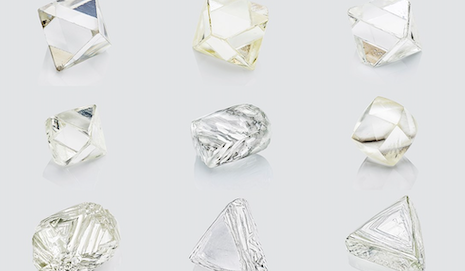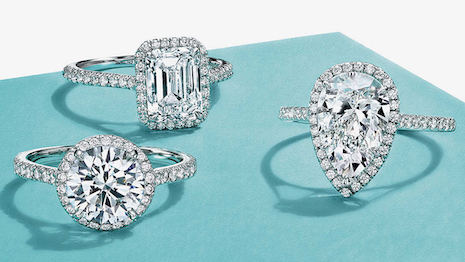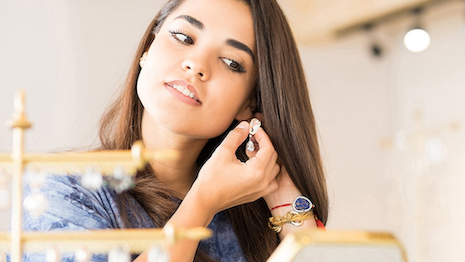In 2021, the diamond industry saw significant growth due to eager consumers ready to spend extra cash coupled with the accessibility of diamond jewelry, as opposed to experience-based luxury spending.
Between 2020 and 2021, the diamond industry shifted its focus on investing in technology to increase efficiency, attracting customers through new experiences and accelerating ecommerce strategies. According to the 11th annual diamond industry report by the Antwerp World Diamond Center (AWDC) and Bain & Company, strong demand drove prices and profit margins, ultimately reversing the industry’s 2020 performance, which had been stunted due to the pandemic and its collateral effects.
State of diamonds
In 2020, diamond jewelry sales fell 14 percent and rough diamond sales declined 31 percent, however by 2021, revenue increased 62 percent in the diamond mining segment, 55 percent for cutting and polishing and 29 percent for diamond jewelry retail, rising above pre-pandemic levels.
In Q2 2021, retailers had placed orders earlier than usual to refill inventories as customers’ desire for emotional gifting, increased savings, limited availability of experience spending and restricted travel boosted diamond jewelry purchasing.
 Demand for diamonds has recovered from pandemic lows. Image credit: Bain & Company
Demand for diamonds has recovered from pandemic lows. Image credit: Bain & Company
After a fall in 2020 of 11 percent, rough diamond prices grew by 21 percent and polished diamond prices increased 9 percent compared to 2020.
Demand grew even higher during the second half of 2021 in preparation for the holiday season.
In 2020, rough diamond production fell to 111 million carats, and while supply saw a rebound in 2021 with a 5 percent growth to 116 million carats, it was still 20 percent below 2019 levels.
Rough diamond sales increased 62 percent in 2021, and miners increased production volumes and pulled from inventories to satisfy strong demand from cutters and polishers.
Production of rough diamonds is expected to hit 120+ million carats in 2022 but is unlikely to reach pre-pandemic levels within the next five years.
Profit margins across the value chain quickly reached pre-pandemic levels. Upstream margins increased 9–11 percent, while the midstream and retail segments both achieved decade-high profitability, growing 3-5 percent and 6–8 percent, respectively.
The downstream saw an increase in online purchasing due to faster inventory turnover and lower operating costs.
From a buying standpoint, there was no shortage in diamond financing. With more liquidity, diamond buyers shifted to cash sales and decreased their reliance on bank loans, reinvesting their profits into the business.
In retail, diamond jewelry sales fell 14 percent in 2020 due to store closures, wedding cancellations or postponements and travel restrictions.
The personal luxury and diamond jewelry markets experienced decade-high growth of 35 percent and 29 percent respectively.
As pandemic restrictions relaxed and wedding demand increased in 2021, diamond jewelry sales rebounded.
U.S. retail saw 38 percent growth in year-over-year diamond jewelry sales and 23 percent growth relative to 2019. In China, diamond jewelry retail exceeded its pre-pandemic levels by 6 percent.
 As weddings and other celebrations returned in 2021, diamond jewelry retail saw vast sales growth. Image credit: Tiffany & Co
As weddings and other celebrations returned in 2021, diamond jewelry retail saw vast sales growth. Image credit: Tiffany & Co
In India, diamond jewelry sales rose 16 percent in 2021 after a 25 percent drop the year prior. In Europe, diamond jewelry retail grew 18 percent but remained 5 percent below pre-pandemic levels.
Sustainable diamonds
In 2021, diamond jewelry retailers expanded their assortments to address a growing trend of sustainable jewelry. In addition to using recycled and pre-owned jewelry, brands retailers have increased traceability and transparency.
LVMH-owned Tiffany & Co. introduced transparency through mine-to-diamond traceability. The jeweler shares the full craftsmanship journey of its newly sourced, individually registered diamonds that are 0.18 carats or larger.
The announcement came a year after Tiffany became the first luxury jeweler to provide the provenance – region or countries of origin – of its individually registered diamonds as it adds transparency to its sourcing of raw material (see story).
Blue Nile relaunched myGemma, a collection of pre-owned, high-quality engagement rings, while French conglomerate Kering invested in pre-owned luxury ecommerce platform Vestiaire Collective (see story).
The diamond industry also witnessed a major divergence of lab-grown diamonds from natural-mined diamonds and an overall emphasis on environmental, social, and governance (ESG) agendas.
According to Bain, lab-grown diamonds experienced continued demand growth and price decreases relative to natural-mined diamonds. The average polished lab-grown retail price declined to 30 percent and the average wholesale price to 14 percent of natural prices, down from 35 percent and 20 percent in 2020, respectively.
In an April 2021 survey by MVEye, 77 percent of consumers were aware of the lab-grown diamond category in jewelry before participating in the survey (see story).
{"ct":"6TrGADQiEOWZTZnL\/1mHjvWL4DODitfGFcR4AcfACZE02lUznEQCu\/pq4\/RqAbe84aARh52RBMr0JYGMyFj1Cf2iLPhv4NCKg2TjpGgZ1q6v68Fjj7pFMmxSVG8teIbcRL5TEz0+doS8Yt+8MI+xQUK9J2zpW2FFoF+WR1foVARDjr1THJhhlwoF0jPPijqj37sArH594iyhIAOIZ0yItSKA5OeexzEkxnXI\/fKRcCI0Dw3BrZnQbJBpwrbSJt6Qnx1cH8cVdRZdrkM0XeuW+b+RT8NnPY3UnqvpAeeYN+rcXC1lAhaj0widqgBbQC086B7yqlapeZJUcAqmr0U6GfVH9vzdZ\/X29NWww5wdzSGzAwuCII2V5mBnrKtfuTFA1WKlxyqrXvNdffHxBC76EZtca\/b0OcLiWilJwsM7af4\/qKeJRjXLQVrkiPLc\/vYUAE8y91zWDdRMHOXzJziG6IGwK2gC0aLsNyCzLYlbV85w6xaxHRGbQr3YU9wkK3DS1ptdqtwuIOwWRBq6cKg2RfyCs769\/EquOBz8b5pzl1EQHB9A0qZl4SY6YAV56fayVvmkE\/5EYcVyUyT7DCELJPzsgJrlyjeOUZl9d845y8HcIFEWMKOxoBLFSlN\/l7nzrKInoxmWMpqBxiROghgqSjjie9XGbVxjS0BFPnbYoDRQVYzT4F8YbTVUqZcLe0CeMBqJMTtoPrKx3Nl\/I4LsqH83TduwSSOp3V\/+R0sTr6HjUZHyhMMecxFowtweq3ZR0zRGCfryUdzIcbc1eNuYrXAT53JcYzBoc8qKJQMQJYLjJwNBGNy5hvUpk5cRyHSMKWj9dlbwDujf3sXvk9llOIK5FwMeZu7\/WEe4OQliEdmuQj6BTSwDttshw0ihg6s447bnGve8CZiKjrDgGzBqIDImEJ0giT0WMJyOfUbhgG9sLBb0uQixZgcTiIcfaUpFoRSuderqKIOqLO\/tqKk2aPb+pegIIAciCl329FuezDHskWQv1IsDAQTEUeXWWvVJGCX2dLp5n8IgYqg3Har\/HL0EUt\/jh0MFx4QE4Dv+UaI5raIoHvl7ZVxYijWSLZXFl2E1fMR8qVqp3du+HvFsQ\/6iglom5xOmHCJa5VA8XdXYOLvWHseupvadc9J3+F6BvgO0MZgO5a3YdG7JuNn54\/8y2ErGLU5MLv5MNLFFaD1SZNAWdg9R0ZAMH2B\/aFFqzwXMv3pLtP3WgMFccVdf5nL9Xe9Bi4cvJ+knbbc8To8t2Ek4xpFlmxVF796mpx5Ebj92boE1wJPqa3IIBP1jT7FTPKRWrV445lg2CrBmRKJAlK6iWCzNiI\/fJdT\/Mdd2gB0nV+sSXklfxo7XQXmcPIWhmgYsNkJe5SNyxvybubOvS28nrH6JtRXGda8PSCiY5NCQ9qqVWQetU19qwCqctaSK+3vzs+EGcNSk9GSYfTtsNVDYCiwcwNP0k6ZvrzObzXso3mFSeWq438SuVVmEnunxin\/SuuEVnqBIsg7gE79W85GVD3RFh2GELEjUCibZVlTcLhhst\/I6fYFriO2fiEeA5cNH39uhrgcl7nDzJ4NpNJqGnBKCVMSIqCZJ6Se46C5KZxE4LGuAjT28xJm2cnktUlyT2D8Vby5oXslGUybeCKJGEQ3VXNsRec7yH\/BSATB\/rXn4zdTn+XoWzKt+OuaSt8rxKENo7dV7nRxvXYjZspQxXL1m5mE4pEIf1ahOLvXqP+WgmEOCZKuK2XvXhNN1G5uzTiHPgjkS4xOhXmMlAZAFkxwxUMQ7gUoY40Htr1t6lRXZfGlr10X7O+0ckGnmruJxP+HZPgF+lCz1M+5hHoyRpBiL1CIvtJEGpAmpci7JxRcIsi3EneWSgo8nNiAVEoMD8UqnOy\/2AM+RE\/pcpAUSyo9pMgbBaqeQmeXvib+wh2YkpfdZBq3GvE2qlfmNELB2vIRRSLNXgWTiXRNk3keW0qYf+IOvh9+KavPdCP9\/dDc4PDij38clHrXv\/kvOWvaGKep5F3O30IDHe0SLyELjNbnO1Dwk7bbvNvZy4pIzl7NxqABeVjd3rmNBLl2HNV3+qtTBbn2XKxd2G8ZsoPfjzUjBiKKNwnQNKW9QbZ0MC28x\/O5Yrkj7aN4AyZd1WPbKHQ4JbCUNjP0lut66Wqqhuxx05z30wDkVaNKhNEKPO3ZmkWSoGpeci4CptycDTjbta3kQr2IFQM2cIbf3HHBr8uBdNBR+h+Wk9bjHipVR5d9EjuItkOR\/lrM\/6yW5YY5b7peft9lrKyFj6DWyYHbr8koFRIHuOfByUoTz3pm30UFy3V+j91vfQ8Ncld5S8ztbmuifo6p2eVSXupTTPsYlUpN3JxF9AyQznWOZwfGZprfb80Idz2DPKd61nmiWyVVE\/sZRf8JePbXBluDdbSkOy8rufDt7ZZFTR2MlgkPe\/tyIkuqDuegWxy5KHLSPKazX0c\/V0bmNfHz3E2jFK0HIFezAiKXIU70vdAW6fI+mEvtRh5sXlETZLH403A1DWb8HVOlSJbjHDx4\/Az7JDv\/PiVRu2\/VYvgT1X5IWrBMD09u0ZcJ8WHBvghf\/CgBSwFK+o\/zhPIiVjBRUi3rHgLZcqkPrp69BdOb2c6buws2\/2DfuI+\/MtUTxdHyfTgGFKfyAxplycG4m\/qOvQUnWoYlrrdJjbyA5HK0uJh3JY0jpP3d+G9wxWXfpQwyfs0hmVLfCiu4PRr48L1CnBlDfk2ESzbNDMCtIgg5Hj0v2jnAWZjOYEerMX3rnbKtDoEXi4sYGwzs830k+jTELj5yZDeZC6h1Oa8egyHffnxiG\/hP3OAw8\/ykxlbOabuPFGsiHKBV9aBdM5gRVy+e+meXk3p4i42897gRRlPw8o+IIII2GW+srG3RGnyPLsKcfN1Oi8tyRleEP78NuYC\/aV+bkAZWn8vLJZShO\/r1ddw2MzKMysVcnn96BwosLc1tdkXIOLXvvAPjV\/yr1b7RjgG7s1yWafdgGpo6GHSTxz9qpUlsk87u+OU7u4Ym0Q4\/AYnJjBtDu9sfD7u9rnLJ3mVohE9hI4Pv0zxYXxWXoReh7W0izPswhO\/1SLb0sw7sDrMW8NCiBaoEBBxYlkylhanrDyToJNlzz34HPn\/e+YkBq7GOiOvl13IJLv47PXLE+leDxJzMv1K5Z\/ppMt5tIerevP8HoOmdldCwZOtO8eLQWvpaQSyV7KSe8r4MHeM78MIGV2GRqAojet4exlocivkQ2yecizS7RqIsb0EM3kzM3pmH5RRiYlVx5ASRXNVTvj2YikUbmXMMVsNHw9\/2Hpl\/j9HmB5LWATgJ7aYN+IiI8q1JOVcATfaocr1ZtjBupBKXKmGaeE6fG0AHeNQp\/awcJhXuwV\/SbZynEuEagzmzsrm960ju+o3Ui5nQDCG012qCv6vVSm1lqM1IUnO+hL+z+gGmdx\/s9Bsa8roeG0ndskJXEMeBIbrfc8evEWVegz\/hILWF+u6K4UIJ41j0wFynguyi0QO+tz0wM4MkmcM8q3gtXlDI+1LuM5UzrfDndfJg0LJNOG1AFo59VA4p3b6lvzyAmQDb+1MA+qJMZGYaGqz4rY8NxYswtzCq7UYJTkZdcBFcQHHgcxeVdN7FokUluR7zxkzY7NNYEKHBLM36EKwIfMzCyq84R8fILq52LJ4C5cOzNY1EvuFkZ1ukUdMVAWpvmFk1m708eXUZsPaxKhXMG3P1BxdVLVqso45e2ynw2PiZcdiUc0+jgcBgzqWuoEy5YPi\/33fxljYoYtfJOAgfy03F5k+fxRaAsrSuZA7BvSglcABpCREgtz2eRdNtnrwWfJFShaP5yWGs95qVhdVhWIeklEBfCFZ6c7aP5Ld9YAdIr23az4kKtv+Y6uktKVc7dJ3450H5b\/xU1yOFseQGfUCTTHkFCfHc+6RUJCzO1K3V3iOQ7EhYilrY1u7AnusoKuMCo5sZhrlP17VQiTFG1ST20bs2twgb3C96Uw55rMYYsE\/gud6zRbldkabxy1a5Z7t7i7tDJOEjqUJHyo1c8Udg1w6xvaOmE94kJG8rB4vl6m+oMRURVJQOsZlVSvNRR\/UeerXRg8B3Ml3QIFt\/XH67pcBG9xix0dKOjcG3A2KL7xisXaSywcW+Wy3I78CjeKWwHkDGt8iuoDv0w0TLq6L+PgvABiyH1LJfPImsW9IhFIhtLBshRQf3XZGa6oHB5+NfZY7AH3gUBKzdmrNWfikz2fJQq2J1tBgMqtIW7VA21tmZj4CX6gpBpSvsX0nkf4IyKvbNqI1+87Q\/5hWd7mpxnIIcIVL7waob4L+GJkpDX5uIbzNSawy+QQnm8Vne+EnGwjSgXsslS5axdGljvFTboW+GeIu2Jh7Q2SGu8rc3\/a+cfr9svPDt\/gZ59FEOrQxpvXQU8WOcMNDWxbrAoxasFOSfIcQQ7u\/ZjGULn5zlu1Sq9iV3qpDqN8uAn4VGuaBNCBQfd36Eiz61bmG1sp22xTAitDUpSP\/hqdVK1LY9F5DNSEjAakY8XFNMbkgYamsOMYeW\/8T6qz6QvjFPDxhHILHAo5zaf70sc+eYKeI3xa18plfBt2czAHLSOfhUsjiV7Ex7Afg3B60KlpnKmpy08Ig0wUlPU5qgxGxCso8DZ68ThzrtaQ\/m6xdh0l6wtw+AEwB3Gx1TEHuF8IadPXkkmvLzWuEMWu9UZX8F80tVeONYOiOTR6iYBD99wm3RnAyHKRYocB3P5Bo\/Ye3EOstgAnviSpYcURgt11AemB39C5Em72Dso+qz4M6r09kvc1JZHqQQ2GynjgNAC4tymerUgN5i3uhtgCtKHsvxYufPRvh9HL5znvHNXvH4Uzd4\/rYWe7oIqISeyvtagcHHlHu7rXcp4zxh1ZDeqQxmwYIR3NzhBmRlZNnne5QMeYfdyp+PeVZJ6rmCy3OU07+sMtNobo8uzni2\/RzztL20b69QoMWIRADPC0WXBp4gt+mFLL6uejtx+EHc\/LnXPncMiF7h6ZVcjnYiH4qrPDY0hddOA9rrpQayjN7B0iXTpb6LqatgsAWhOb\/uUyoNcWMk1uzAZ4JHDY2ww1u8aiV9dVacA\/IVgtUdDttT+yRf7jOi2GkXy9XabBSic6ZGgStMKYWGUSJH2nObDFOqfWpKqX1QA\/yUKWAFdO4pSmAYE1tdV0c+Tj2dZMKbB5RWCEjiAHtHsqSZ\/pvKee9AMyqfRNNvDHfTycJN16pumTdfyqX9gb8qV9Pv96afiH49UVzFqYl4PqOIlHE8m02nGKAe5sJcnCkvZm4\/USNLdJTpb3C7+3T04HmrSPGGAvvQ\/CG46lCrTQUxboaK8jv0+AoKIvnbtzvvLMKtvTjQ3oNSUH0legIMbtmtgI4221CL75R6PevvbcsXQAxp\/IEtmHUk\/ZERjFQs53u2bY\/bK25lcbw60k4nbsarTmnm0ucQaPXuEEwlKldQf5aE8RBhBUeQN9MDFTnjBr1TDj35uKx7T\/\/9c5RWHPHRY3AjZ2g0pcgFXPiVu0VO4HFFtix9CW6tHqPvu3uxmIiG\/YOIicIHD41ORVgvkTWmSelbq7rIq4xi1VCjBmdLGkuugoy\/A1iWt0i4nLf6XBuSbhRc65g4s\/9Q7YZe2zMObDnqgheZFHWuuymTCa2fgC6iqrxkl+EJvVcBujCYOVvStGvjjECW0lGloikvqJrL5WtWO07XlSIy8nELjnChVSV29Y\/PoeFfoKJftIZP6QBGdmgRWqe95QgpOC9HOHmdIhP2gHE0qkQjjLRKg1Q3wemeFTKJJWMHi2xZ6isNnkc5lVGWx\/M+KQwQoO50FpY+WMM0HGz0uFGX2SxfbRjibbEhU3\/p0L+cVP6JHLLMPv\/5uE5Tc5dEJQIiaQRNzjD3VrHA0HzW3BKZ5v4LueKLL0X7LpPejD47Zj1X91UJLOD6pskR6weRmeBCePGbKYWriFkn1n3gPNS2gh2uhX8kbnHkB7+d2XgfO76B6QALfDcQ8GmgaPpMXpCTrgUdjSsTCTPdGyx6FudiXAvb42gFJXROWWnXfr+Bfb3Mkgj0lDTwn6DgbmLmiMFf6XGlr0YBb8O6EQHKnuC0cCnVO0m1T7jBdLo1vBPRNrUTrqiEa673AWBKDw\/nURjkPEF5peJvlARG5gH05q0lgnKxmfsNronX2J2CTHmEjsdn9ObRNqsHPZqjkOJ1fSBcZoqZfugu7vFlyHsXC\/2h6IH+1gs42IY8Ygze+fSSbz6TnTDcr57QmOuogtd1HG9g71myyMnsthtFPTBkcOOpYePLzED4R3FrywrOXbBUsu89Sw1jXtApTkLj3LT\/sWGGS1XFxCElmNxyQlVBc9XGKDVkzCCqyaFyW8CJ7jQesAGHMMTEZpnT4znq\/hQ2KObDPn+Nbok53g0xpnAQQJvAe5hG5TkH4K2o4aASQlZy0+a7+paCILq0zZgCipJkzmDc9Zz+2YgfFyRv35I9rqTeJXaKDKByNWuCnJ25wGWtLhzB\/tWV4XOc44pGfbGkuKVs5tiqQAmfs4StkSsI1yfGoif3Gws\/YTNq7yApUTY6aurCBq3fHqInFrySOx7\/usHTrn3Sneux2uUlUi81zqx\/BCir15GZCBmbEWyXkP4b9XY5ChHWdpOTrriGPoe26ZObcr3ZaYIdEzTGRH2whJYazd5vv2vxIHCjVXYMnI8jyZDDka753nA1XjpkFJIrkw5YJlSPJHoWVdZoFiYD8yBEt5+lqCT\/k8xKBoobQ\/8NbPbsGOJHsbV4Xg6cgqMI36Us5FgqRDcnwgV7APqfd1o4Vl6bB44YSUFcF5cQxGsOonUclEC0FCycLMY2PImmvdr6tZiKrqTX3+46Y6Xoy+saGaAqbsebDASpehLyyFTz\/2z7Alg7qHreAH1BmSaVgJPvLQskhIJ2xn3QyegJ586VhfiV05BfySb61gQxWgXfxbW29nc6QBV1FmflLrH8EpqE93kpAoYs+q2FPyxnouwNVPJHrZn5u163flfYxoNgm2pYEp10CJmSjJQmZPI9LvP9cp3CuEqEgq9lxjoYLBwsbDAmtMLuHhVZdB4w4IY0Vp5Ogt18PK61Aiy6OS2z53rl8d\/XZa80z86oNNCuUdN9O\/HOTtKRQkMICVfKFWSqi8BwvK4KWWOCvuQVo3cYfmxVZF\/ihlOap2S5ORtYcMw555whHeurcwPOrig8EOVOmuf+bp\/SQVzJiXY\/SzO0G86BTBGUnGQ1Ju3QJd\/Dvk1Ud98oqHvRj1N2ktU+semfy+jyMHyZt+1LhSrwbmdZBw8MIBenwh58gZ9UMV06wgDHQTPdldwjR+5PEXWkVbwcAsJyiSHJqQquHmfvTEw2gNX9uBefOqFEnOwyhuBxI6fKe9S05VDnOCYhwENYuo5vA6Xwm7wArG4Q\/mCzMbV9uv10mvWy0F\/IV8EaR3\/TqoNV7TqyhkAHqzFRTKLUDuD4YzF8EJriQditJSqL5H6vldyHh9UwXh5IZgE\/iPoQpc7xODJFe0ngcEYgqL0X1iqH00KXwXc39TlnptDRWB31wS4WxScw1UQz62LaJqPrEkdY66vbvo+tUc71tt53i8ANu0O\/iBS9jSihMYxtQqw53goB91c1zbby2WsoT8H2iLiO9EF1H7TTdwmbHEdS2OQbT5CLjBbKUcowsjpc4De9+ZawSsjFjySf2IsOFbOOB3qtqe+xrUa+Oa1oTRtTdDApzA3LI3Biscxhyv8WfN9upqcgvQXbAmT0FRpO33VM1E+BcDIY18xBmdbK7UKRzjABRrwl1MFji\/ZKOCtOaTHyT3xmMFFLjZOKemalHVpnW2TAcP+X+xh5wQTMINm1a0SrWCbV\/eGLbJLhupohgwLo4NtxW6rHkkiPIdhsQI70TYdyrY02K6r46CHTRg\/RBOAmMSIj+591fWRUo3pGTXKk9buvmxiwRcZNysjvImVXHD8DGoVFYAufhkxT4aUAF8FrsMWcyyAREI2SA5KsrD5zUQbyGrU\/I8BzWWMujkaJq2BWoQRnfESEpdSoxU86ZY8OozQTK8W81o\/6HEOeQL3Ui65uGjE1v\/9twWZdGAcMAI\/C1179Uvz+RJlsAtJVBuuyQ4DN35aneE7xXGYhO2UQ\/MYpkp7WVngs2C4OXv7mg5kbflsrp1XTAnHjP6\/qq73crIWhc59War2Mcj\/VSTette+s9hhfSDGsGr9hMKLHELAUwDULNB6puF5L+JmG4lmuyvCeWDc2rxK4141tyfgV2F8tp5\/YakWwPrtiVxUNJin2i178gzMuB6GszHyLfZTuMEI4o4AN\/5H9zZQ1Xq1+lklwoDeb6XqLTu9WJrO1D\/owz3J4eFD19St3d01RFTirORPFohcVq0DenvN0S38pezr3BP1Pc3Cy\/VpM+A0zjbVRFVEaea82XicPIHzsZRMfhIxcgSxGLUqBikqiMZ3dtBH5L7iuw8DmnCVyxruO5LjRuOx2mx6Ls6W997cKxIdbQZdL+xkllu9GSkCHu\/SeqeqCeQWpdjCzy9IuIakMWn7YQYchBQGoAKaS6D6B\/ow2js1He++uB\/njvGBwC02pBaGeHW8mWBW\/xs\/EBdv590L0yHOaCX\/PZJ9FU8+fVK3QGdJNnwuzZYugY5htkcepS8ksnZX+KbTRYEjAyryuM4OyXhJu9pbdoX86gciq7UfS0KYv1yMskY9ZOBEjxw+DMtbQMkmo8l7ZfQMHPDn7w6Bsojmxfxr16z+taRW5q8UZkYBr3ks7p9QB2hc3bgaTQ0AJ+l6ilexfvAMsH4rlouKp1+e2Jbd2JRkdgYlal2v4P3d2LVW4EohAhvhV1vAo75nPGqT2mWvCo51R2MTqnNSUUe76xUXuF1g1Qto\/VpsDMDicDhGNMRSTnIRBSCJs1+ajUnk111oNN+eMOFI4NP9brh\/0UC2Xcfx0E1fKX4HUNoygOl0ja9oWo7A28wKixlZSfbvCJXnoHo4\/IXToose+zJmWF0eN91KyPCeB2dSKNdJQgni6Oyzmi2ygyp0W2KggodfDKR8KnCdbIrWH2n+ElygtoMkTptg\/ak2B+VPJ\/q2nzvtr9dPkKzDf9OBbc+0AQ\/SlJzPd76RW2J5ZMBoxlMWI71nJcnZfriNuVLsbo64d9+mXoMln5On9gGjw1yt34nRquc\/5oBsUE59fUB4amXt25dfz4saKSnV6Op6F5ad5fudZI2QKk9LM00WWsHguBynw4jTYqVbQVEkzf13EyrsCDPpFW9dZxYZ17\/1pmVEvI74dGEM+VP8wvT38xBEVt4WwizY82CEEHAikn","iv":"ea92feefded7b93db5c5a8faeca08616","s":"311d46a74bf040b5"}

 With more expendable income and fewer options for experiential luxury, consumers consistently turn to diamond jewelry for their luxury purchases. Image credit: Bain & Company
With more expendable income and fewer options for experiential luxury, consumers consistently turn to diamond jewelry for their luxury purchases. Image credit: Bain & Company  Demand for diamonds has recovered from pandemic lows. Image credit: Bain & Company
Demand for diamonds has recovered from pandemic lows. Image credit: Bain & Company As weddings and other celebrations returned in 2021, diamond jewelry retail saw vast sales growth. Image credit: Tiffany & Co
As weddings and other celebrations returned in 2021, diamond jewelry retail saw vast sales growth. Image credit: Tiffany & Co